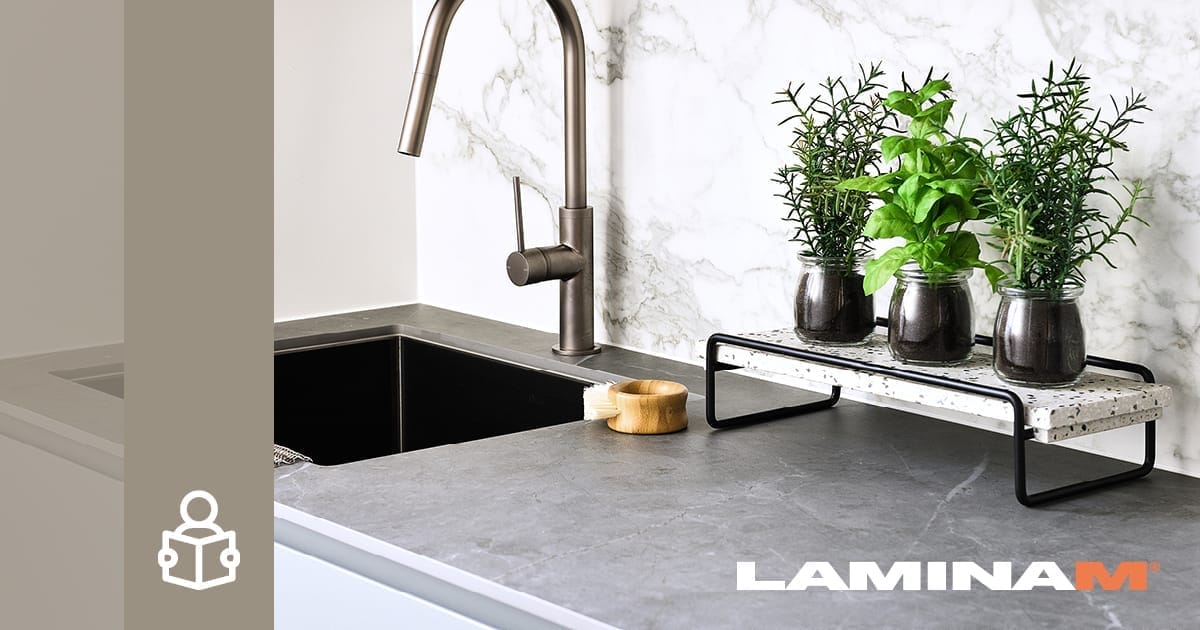The Maintenance Of Tops Produced By Laminam

The secret to ensure the long lasting of the original aspect of the tops (kitchen or bathroom tops), is the correct cleaning of the same. In this writing, you will read information, suggestion and warning to maintain for a long time the aspect and functionality of your top. Today, we talk about LAMINAM® tops. Attention: the publication of this article and of the following ones mirrors the alphabetic order of materials discussed.
THE LAMINAM® TOPS
LAMINAM® is a porcelain stoneware slab produced via humid grinding of clay raw materials, granite and metamorphic rocks, and compacted by a special compacter casting and a 1200°C hybrid backing sintering. Thanks to the manufacturing process implemented and to the high quality of raw materials and the baking temperature, the LAMINAM® surface is highly resistant to heat, very hygienic and resistant to weathering agents, to stains, to straches (*) and with an almost non existent surface porosity.
In the ceramic material there are no traces of organic components therefore in the domestic use it is resistant to fire and high temperatures. The surface heat resistance allows to place hot pots and flatware directly on the top. It is possible to leave the food in direct contact with the LAMINAM® top: the surface is hygienic and resistant to molds and fungi. The maintenance and cleaning of surfaces is easy and fast since LAMINAM® is resistant to spots (*) and to cleaning products and detergents (*).
(*) These characteristics are not guaranteed for LAMINAM® LUCIDATO as it has a higher sensitivity compared to the other LAMINAM® surfaces as this finish is achieved thanks to a thorough mechanical post-baking procedure.
WHAT DOES RUIN THE LAMINAM® SURFACE AND WHAT CAN BE USED TO CLEAN IT.
We recommend not to cut foods directly on the top because the knife will lose its sharpening. Contingent signs are caused by the knife metal and can be deleted with acids (i.e. Anti-limescale products or commercial muriatic acid) when they are left on the surface for about 10 minutes. If needed, use a slightly abrasive sponge and check a small portion of material first. Do not use ceramic knives directly on the top as they can affect the finish. Avoid contact with adhesives and silicons as once they are dry, it is not always possible to remove them.
Furthermore, for LAMINAM® LUCIDATO, avoid dragging on the surface objects such as flatware, pots, knives and generally speaking other hard stuff. Use chopping boards when cutting foods and pot-mats, place mats etc. to avoid rubbing on the working top. In this case, do not use abrasive sponges or soaps. For all cleaning operations, we suggest to run a preventive test with the product to be used on a small portion of top. Please note that generally speaking, the sooner a spot is removed, the easier the removal will be. Halos or spots seen on the surfaces are usually the result of an incorrect and not accurate cleaning. For the daily cleaning of LAMINAM® slabs, use hot water and neutral detergents if need be (i.e. Surface soaps or detergents) with a cloth or a soft sponge. After that, rinse with abundant water and dry the surface with a soft cloth or blotting paper. To avoid the creation of opaque coats, do not use products entailing polishes. Do not use abrasive products and sponges.
SPECIFIC TREATMENTS FOR DEKTON® TOP SURFACES
For the removal of particularly resistant spots or remains on the LAMINAM® surface, start cleaning with hot water and neutral detergent. If this is not sufficient, use increasingly strong cleaning techniques and use specific products depending on the spot to treat, such as: non abrasive detergents with neutral pH, slightly abrasive detergents, acid detergents (i.e. anti-limescale) or basic detergents(bleach) solvent-base detergents (i.e. acetone). After that, rinse and dry. To remove contingent remains of dry materials on the surface such as chewing gum, use a wood or plastic scraper. Continue the activity with a neutral detergent and a soft sponge or cloth. In case the top is stained with ink or felt-tips, clean the area immediately with specific detergents such as: nitro diluent, trichloroethylene, solvent naphtha or other solvent-base detergents on the market. Avoid spreading the halo on the surface. After that, rinse and dry. Contingent persistent remains of graphite or signs left by metal objects, can be eliminated with the direct contact with acids such as anti-limescale products or commercial muriatic acid for 10 minutes. After that, rinse and dry. If needed, use a slightly abrasive sponge and check a small portion of material first.

Leave a Reply